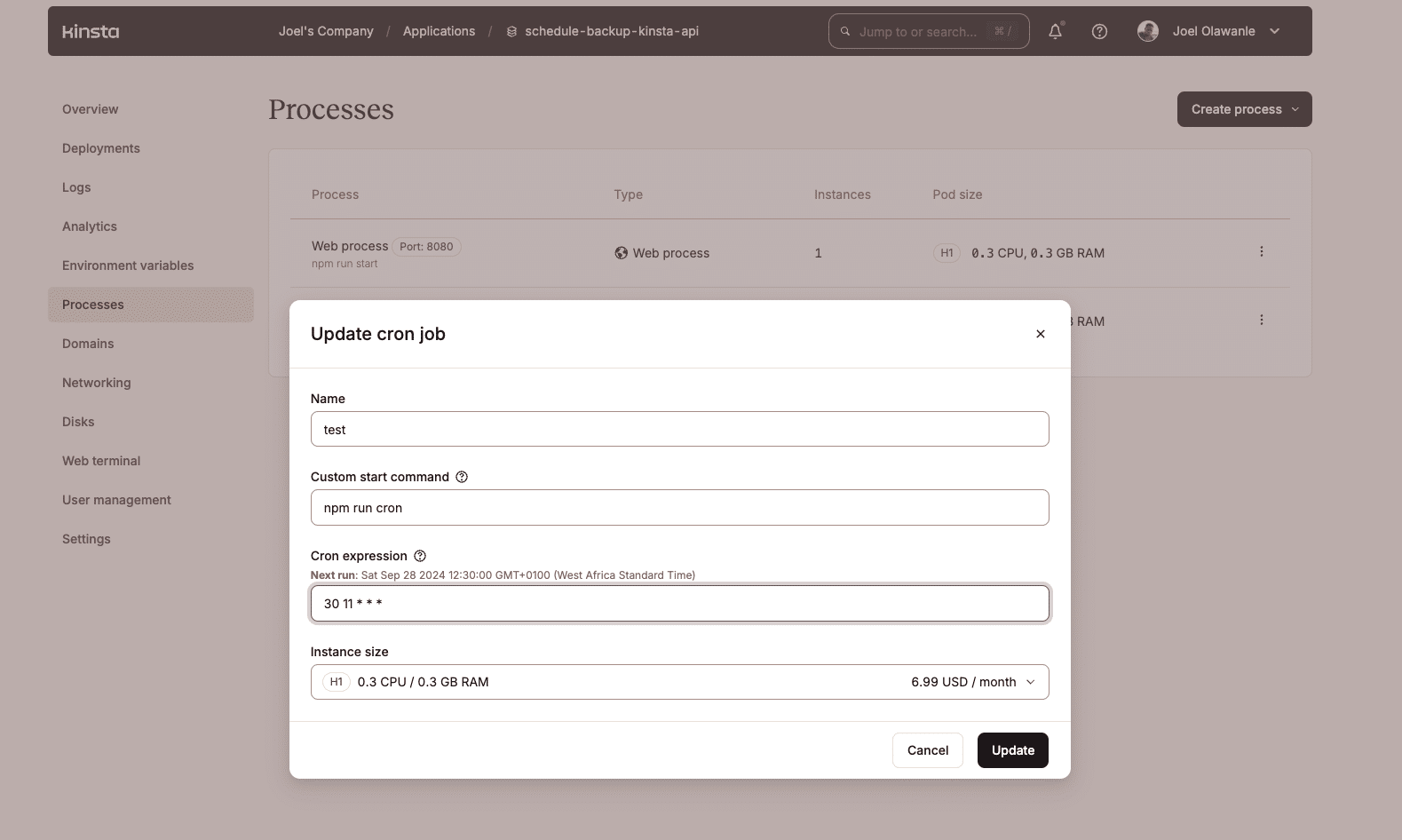For wordpress companies managing multiple client web websites, having a powerful backup technique is essential. Throughout the fit of an sudden outage, plugin failure, or human error, backups be certain that knowledge can be quickly restored — minimizing downtime and reducing client risk.
At Kinsta, we understand the the most important serve as backups play, which is why we offer six backup choices: automatic daily, not obligatory hourly (and each six hours), information, system-generated, downloadable, and external backups sent instantly to Amazon S3 or Google Cloud Storage.
While managing the ones backups is straightforward by means of the MyKinsta dashboard, Kinsta’s API opens up great probabilities for automating repetitive processes.
Believe simply typing a command in Slack or setting up a cron procedure to reason backups for your whole wordpress internet sites for your Kinsta corporate account without manually navigating via dozens or even a number of web page dashboards.
This flexibility is one of the many advantages of the usage of a number that prioritizes its customers’ needs by the use of providing them with the tools to create custom designed, time-saving solutions.
This knowledge explains learn the way to leverage the Kinsta API to automate backups right through multiple internet sites. Whether or not or no longer you’re integrating at the side of your hottest stack, the usage of tools like Slack, or setting up automated schedules, this data will provide you with the knowledge to streamline your backup process and toughen your workflow.
Enforcing backups for all internet sites and made up our minds on internet sites
Previous to diving into scheduling, it’s necessary to first understand how to reason backups for all internet sites for your Kinsta account and learn the way to objective specific internet sites or environments the usage of the Kinsta API.
Once we’ve the foundation for rising backups, we can merely mix scheduling to automate the process.
Triggering backups for all internet sites in a Kinsta account
Like with each API, there isn’t all the time a single endpoint to do the whole thing you wish to have — you incessantly have to combine multiple endpoints to achieve your desired end result.
The Kinsta API isn’t any different. While there are specific endpoints for managing backups, the ones endpoints require certain parameters, similar to atmosphere IDs, which you were given by the use of making additional requests to other endpoints.
For example, to reason a information backup for a web page, you wish to have the environment ID for that particular atmosphere. To get the environment ID, you first need the web page ID. This means you will have to make multiple API calls: one to get the web page ID, another to retrieve the environment ID, and after all, a request to reason the backup.
wordpress-internet-sites-with-kinsta-api”/>Step 1: Fetch all wordpress internet sites with Kinsta API
The first step is to retrieve a list of all of the internet sites comparable at the side of your Kinsta account. Kinsta’s API provides an endpoint to fetch this data, which comprises web page IDs, names, and other comparable details. The use of the GET /internet sites endpoint, you’ll be capable of pull a list of all internet sites underneath your company’s account.
Proper right here’s an example the usage of Node.js and Fetch API:
require('dotenv').config();
const KINSTA_API_URL = 'https://api.kinsta.com/v2';
const API_KEY = process.env.KINSTA_API_KEY;
async function getAllSites() {
const response = watch for fetch(`${KINSTA_API_URL}/internet sites`, {
headers: {
Authorization: `Bearer ${API_KEY}`
}
});
const knowledge = watch for response.json();
return knowledge.company.internet sites; // Returns array of all internet sites
}This function returns an array of all of the internet sites for your account. Each web page incorporates information such for the reason that web page’s ID, name, and atmosphere(s).
wordpress-web-page”/>Step 2: Fetch atmosphere IDs for each wordpress web page
Each web page will have multiple environments (like production or staging), and backups are brought on in line with atmosphere. To retrieve the environment IDs for each web page, you’re making another API identify to the GET /internet sites/{site_id}/environments endpoint.
Proper right here’s an example function that fetches environments for a decided on web page:
async function getSiteEnvironments(siteId) {
const response = watch for fetch(`${KINSTA_API_URL}/internet sites/${siteId}/environments`, {
headers: {
Authorization: `Bearer ${API_KEY}`
}
});
const knowledge = watch for response.json();
return knowledge.web page.environments;
}Step 3: Purpose backups for each atmosphere
Upon getting the environment IDs, you’ll be capable of reason backups for each atmosphere the usage of the POST /internet sites/environments/{env_id}/manual-backups endpoint. The API implies that you’ll create a information backup by the use of providing an environment ID and an not obligatory tag to identify the backup.
Proper right here’s learn the way to reason a backup for a given atmosphere:
async function createBackup(environmentId, tag) {
const response = watch for fetch(`${KINSTA_API_URL}/internet sites/environments/${environmentId}/manual-backups`, {
way: 'POST',
headers: {
Authorization: `Bearer ${API_KEY}`,
'Content material material-Kind': 'tool/json'
},
body: JSON.stringify({ tag })
});
if (response.good enough) {
console.log(`Backup created for atmosphere ${environmentId} with tag: ${tag}`);
} else {
console.error(`Did not create backup for atmosphere ${environmentId}`);
}
}This function triggers a information backup for the given atmosphere ID. You’ll moreover tag your backup for easier identity.
Step 4: Automate backups for all internet sites
Now that you simply’ve were given functions to fetch all internet sites, retrieve atmosphere IDs, and reason backups, you’ll be capable of combine them to create a script that automates backups for each web page for your Kinsta account.
Proper right here’s the way you’ll be capable of tie the whole thing together:
async function backupAllSites() {
const internet sites = watch for getAllSites();
for (const web page of internet sites) {
const environments = watch for getSiteEnvironments(web page.id);
for (const atmosphere of environments) {
watch for createBackup(atmosphere.id, `Backup-${new Date().toISOString()}`);
}
}
console.log('Backups for all internet sites had been brought on.');
}This function loops via all of the internet sites, retrieves their environments, and triggers backups for each atmosphere with a timestamped tag.
Now, while you run backupAllSites(), it triggers a backup for each atmosphere for your Kinsta account.
Slack command example
You’ll mix this backup process proper right into a Slack command for much more straight forward regulate. With a Slack app setup, shoppers could cause backups right through all internet sites with a single command like /backup_all_sites.
Proper right here’s a to hand information a coarse example of the way in which this is in a position to artwork:
app.command('/backup_all_sites', async ({ ack, say }) => {
watch for ack();
watch for backupAllSites();
say('Backups for all internet sites had been brought on.');
});Triggering backups for made up our minds on internet sites the usage of atmosphere IDs
In some cases, you have to need to reason backups for most straightforward specific internet sites or environments rather than all internet sites for your Kinsta account. This may well be useful while you’re thinking about backing up most straightforward production environments or certain high-priority internet sites.
The use of the Kinsta API, we can automate backups for made up our minds on environments by the use of passing an array of atmosphere IDs. Let’s walk via learn the way to put into effect this.
Step 1: Transfer atmosphere IDs
When you need to reason backups for made up our minds on internet sites, you wish to have the environment IDs for those internet sites. You’ll each hardcode the ones IDs, retrieve them from the Kinsta API, or transfer them dynamically (like via a command-line argument, Slack command, and so on.).
Proper right here’s a function that accepts an array of atmosphere IDs and triggers backups for each one:
async function backupSelectedEnvironments(environmentIds, tag) {
for (const envId of environmentIds) {
watch for createBackup(envId, tag);
}
}The function above receives an array of atmosphere IDs that you need to once more up (environmentIds). The createBackup(envId, tag) function triggers backup for each atmosphere throughout the array the usage of the createBackup() function (outlined in Step 2).
Step 2: Purpose the backup
To reason the actual backup for each atmosphere, use the Kinsta API’s POST /internet sites/environments/{env_id}/manual-backups endpoint as we did for all internet sites. Proper right here’s how it works:
async function createBackup(environmentId, tag) {
const response = watch for fetch(`${KINSTA_API_URL}/internet sites/environments/${environmentId}/manual-backups`, {
way: 'POST',
headers: {
Authorization: `Bearer ${API_KEY}`,
'Content material material-Kind': 'tool/json'
},
body: JSON.stringify({ tag })
});
if (response.good enough) {
console.log(`Backup created for atmosphere ${environmentId} with tag: ${tag}`);
} else {
console.error(`Did not create backup for atmosphere ${environmentId}: ${response.statusText}`);
}
}Step 3: Execute backups for made up our minds on environments
Now that we’ve got functions to reason backups and handle multiple environments, we can combine them to once more up specific environments. This example assumes we already have the environment IDs that we need to once more up.
const selectedEnvironments = ['12345', '67890']; // Change with precise atmosphere IDs
backupSelectedEnvironments(selectedEnvironments, 'Manual Backup');In this case:
- The
selectedEnvironmentsarray incorporates the environment IDs you need to once more up. - The
backupSelectedEnvironments()function loops via each ID and triggers the backup with the tag ‘Manual Backup’.
Slack command example
Will have to you’re the usage of a Slack app or command-line interface, you’ll be capable of moreover allow shoppers to specify which environments to once more up.
Proper right here’s how chances are you’ll put into effect this in a Slack app:
app.command('/backup_selected_envs', async ({ command, ack, say }) => {
watch for ack();
const [tag, ...envIds] = command.text.lower up(' '); // First section is the tag, recreational are env IDs
watch for backupSelectedEnvironments(envIds, tag);
say(`Backups brought on for made up our minds on environments with tag ${tag}.`);
});The individual inputs a command like /backup_selected_envs Backup-Tag 12345 67890, where Backup-Tag is the tag, and 12345, 67890 are the environment IDs.
The command’s text is split, and the environment IDs are passed to the backupSelectedEnvironments() function.
After triggering the backups, the app responds to the individual confirming the backup.
wordpress-internet-sites”/>Scheduling backups for your wordpress internet sites
Some of the tough sides of automation is the facility to schedule tasks at specific events without information intervention.
Now that we’ve covered learn the way to reason backups for all internet sites and made up our minds on internet sites, the next move is to automate the ones processes by the use of together with scheduling.
Whether or not or no longer you need to schedule backups locally, on a hosted platform like Kinsta, or dynamically by means of Slack, there are quite a lot of ways to put into effect this.
Understanding cron expressions
Previous to exploring different approaches to scheduling backups, it’s necessary to grab cron expressions, which are used to specify the timing for scheduled tasks right through quite a lot of platforms and tool.
Cron expressions define when a task should run. They’re used in many scheduling libraries and products and services and merchandise, similar to node-cron, node-schedule, and even server-side cron jobs like those available in Kinsta’s Utility Internet hosting platform.
Cron expressions consist of five fields, each controlling a decided on side of when the obligation should be finished. A normal cron expression turns out like this:
* * * * *
| | | | |
| | | | └─── Day of the week (0 - 7) (Sunday to Saturday, 0 and 7 represent Sunday)
| | | └────── Month (1 - 12)
| | └──────── Day of the month (1 - 31)
| └────────── Hour (0 - 23)
└──────────── Minute (0 - 59)Let’s spoil down what each field represents:
- Minute: The minute of the hour when the obligation should run (0 – 59).
- Hour: The hour of the day when the obligation should run (0 – 23).
- Day of the month: The specific day of the month to run the obligation (1 – 31).
- Month: The month of the twelve months to run the obligation (1 – 12).
- Day of the week: The specific day of the week to run the obligation (0 – 7, where 0 and 7 every represent Sunday).
You’ll use specific values, wildcards (*), or ranges in each field to stipulate the schedule.
Examples of cron expressions:
0 0 * * *: On a daily basis at nighttime (00:00)0 3 * * 1: Each and every Monday at 3 a.m.*/10 * * * *: Each and every 10 minutes0 9-18 * * *: Each and every hour between 9 a.m. and 6 p.m.
With a solid working out of cron expressions, we can now switch at once to different methods of scheduling backups for your wordpress internet sites the usage of the Kinsta API.
Approach 1: Scheduling locally with node-cron
The Node.js package deal node-cron can run scheduled tasks consistent with a cron-like syntax. It’s easiest for running automated tasks in local or standalone Node.js programs, and it’s a popular variety for scheduling backups, sending emails, or executing other peculiar tasks.
In node-cron, you define a task (like your backup function) and use a cron expression to specify when the obligation should run. The cron expression consists of five fields that define the minute, hour, day of the month, month, and day of the week when the obligation should be finished.
First, arrange node-cron for your challenge:
npm arrange node-cronLet’s say you need to schedule a daily backup of all internet sites at nighttime the usage of node-cron. Proper right here’s the way you’ll be capable of do it:
const cron = require('node-cron');
const { backupAllSites } = require('./app'); // Import the backup function
// Schedule to run backups for all internet sites at nighttime every day
cron.schedule('0 0 * * *', () => {
console.log('Working scheduled backup for all internet sites at nighttime...');
backupAllSites();
});Similarly, if you want to once more up made up our minds on environments at 2 a.m. every day, you wish to have to schedule it like this:
cron.schedule('0 2 * * *', () => {
const environmentIds = ['env12345', 'env67890']; // Specific environments to once more up
console.log('Working scheduled backup for made up our minds on environments...');
backupSelectedEnvironments(environmentIds, 'Scheduled Backup');
});hosting-like-kinsta”/>Approach 2: The use of cron jobs in cloud web hosting (like Kinsta)
When deploying your Node.js tool to a platform like Kinsta’s, you’ll be capable of leverage the platform’s built-in cron process capacity to schedule tasks like backups. On the other hand, setting up cron jobs in cloud environments requires a rather different development from local scheduling tools like node-cron.
Whilst you deploy your app to Kinsta, it should have a running web process (although it’s now not actually serving web guests).
To ensure your challenge runs as it should be and doesn’t mechanically identify backup functions, you’ll be capable of create a document that runs a simple web server. This document acts as a “dummy” web process, while cron jobs handle the backup not unusual sense.
You’ll add this code:
require('http').createServer((req, res) => {
res.writeHead(302, { Location: 'https://www.google.com' });
res.end();
}).concentrate(process.env.PORT);This fashion, you’ll be capable of prepare script command to distinguish between the web process (get began) and the cron procedure process (cron).
"scripts": {
"get began": "node index.js", // Web process
"cron": "node app.js" // Cron procedure process
},After all, configure the cron procedure in Kinsta to call your backup function at the specified time. The use of the cron procedure settings, you’ll be capable of define the command to run the backup.
Throughout the MyKinsta dashboard programs’ Processes tab, set the command for the web process to:
npm run get beganAnd set the cron procedure command to:
npm run cronTo run the cron procedure at a decided on time (every day at 11:30 a.m.), set the cron expression like this:
30 11 * * *This command will reason the backupAllSites() function every day at 11:30 AM.
Setting up a cron procedure in Kinsta’s Application Web internet hosting.
Approach 3: Scheduling with node-schedule
Each different Node.js library, node-schedule, can schedule tasks the usage of the cron structure and in addition is helping further difficult schedules.
Proper right here’s an example that allows shoppers to schedule backups by means of Slack the usage of the node-schedule cron structure:
const schedule = require('node-schedule');
const { backupAllSites } = require('./app');
// Slack command to schedule backups dynamically
app.command('/schedule_backup', async ({ command, ack, say }) => {
watch for ack();
// Extract hour and minute from the command (expects HH:MM structure)
const [hour, minute] = command.text.lower up(':');
// Validate input
if (!hour || !minute) {
say('Please specify the time in HH:MM structure.');
return;
}
// Schedule the backup the usage of node-schedule's cron-like structure
const procedure = schedule.scheduleJob(`${minute} ${hour} * * *`, () => {
console.log(`Working scheduled backup at ${hour}:${minute}`);
backupAllSites(); // This triggers the backup for all internet sites
});
say(`Backup scheduled at ${hour}:${minute} successfully.`);
});For example, an individual would possibly run the following Slack command to schedule a backup for 11:30 p.m.:
/schedule_backup 23:30After running this command, the backup shall be scheduled to run at 11:30 p.m. every day. The response from Slack would perhaps look like:
Backup scheduled at 23:30 successfully.This implies shall we in shoppers to dynamically schedule backups from Slack by the use of simply specifying the time with no need to have interaction with the server or the application code. It’s a flexible and strong option to handle scheduled tasks like backups in a user-friendly way.
Summary
Scheduling backups right through multiple wordpress internet sites is good for corporations managing numerous client web websites. Automating the ones backups now not most straightforward saves time however moreover promises consistency, reduces the danger of human error, and gives peace of ideas.
Would this resolution benefit your corporate? We’d like to concentrate for your concepts. Share them throughout the comments phase beneath!
The post Scheduling backups for more than one websites with Kinsta API appeared first on Kinsta®.
WP hosting
[ continue ]
wordpress Maintenance Plans | wordpress hosting
read more













